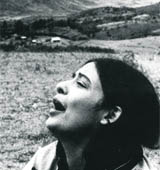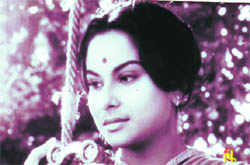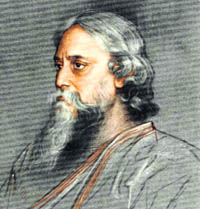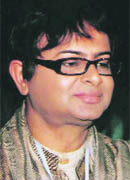|
Rabindranath
Tagore’s 150th birth anniversary falls on May 9
Tagore tales on
talkies
The works of Rabindranath
Tagore have always fascinated filmmakers, as these are universal
— in time, space, emotions and human relationships, writes Shoma
A. Chatterji

Credit for the most brilliant cinematic, hard-hitting and metaphorical use of Tagore’s songs goes to Ritwik Ghatak in Meghe Dhaka Tara |
Rabindranath
Tagore’s writings bring up images of lyricism and romance.
Many filmmakers feel that the horizon of a Tagore creation —
be it poetry, fiction, essay or drama — is too large,
all-encompassing, complex and alien to Indian masses,
conditioned to ‘popular’ literary figures like Sarat Chandra
Chattopadhyay and Bankim Chandra Chattopadhyay. Their creations,
it is felt, are more cinema-friendly. The 14 remakes of Devdas
in different Indian languages is an example.
The homespun
philosophy of Sarat Chandra and the romantic spirit of Bankim
Chandra had more appeal than the non-conformist and feminist
themes, which Tagore dealt with. Yet, Tagore has been recognised
as a rich literary source for very good cinema. Satyajit Ray’s
films based on Tagore’s works offer the best example. In 1961,
Ray made Teen Kanya (Three Daughters), on three Tagore
short stories — Postmaster, Monihara and Samapti.
The other Tagore works he filmed are Charulata and Ghare
Baire.
Tagore’s
works are universal — in time, space, emotions and human
relationships. They offer filmmakers a challenge to make the
film as powerful, credible and appealing on celluloid as it is
in print. A film based on, adapted from, interpreted from Tagore’s
oeuvre offers scope for argument, discussion, analysis, debate
and questions among the audience, critics and scholars. A
massive volume of scholarly treatises came out after Satyajit
Ray’s Charulata, leading to a new genre — writing on
films based on Tagore’s works.
Charulata
(1964) is based
on Nastaneer (The Broken Nest, 1901). Charulata,
the film, and Nastaneer, the story, is set in 1879, when
the renaissance in Bengal was at its peak. Western thoughts of
freedom and individuality were about to ruffle the calm feathers
of a feudal society. Women’s liberation was being talked
about, but not beyond few cases of widow-remarriage and some
education. Intelligent, sensitive, graceful and serene, Charu
was a traditional woman, whose mindset slowly and steadily
absorbed waves from the world beyond.

Charulata is the most critically discussed among Tagore’s works
adapted by Satyajit Ray |
Charulata
is the most hotly debated, variedly interpreted, widely
discussed and critically questioned among Satyajit Ray’s
films. Most of these debates are around Ray’s fidelity to the
Tagore original. Tagore and his works are too sacrosanct for
a filmmaker to interpret otherwise was the general feeling. Ray
responded to attacks on his alleged distortion of the original
through his article Charulata Prasange in the collection
of articles, (Bengali) Bishay Chalachitra.
In Chokher
Bali, Rituparno Ghosh adapts the many worlds of Tagore so
that it reflects our past filtered into our present. Ghosh
concentrated on sound design to bring about the message of the
political uprising in Bengal, happening at the same time, as the
disruption of Mahendra’s marriage inside the home.
The rising
crescendo of "Vande Mataram" filtering into the
home, the sound of the horse carriage moving away to suggest
Mahendra taking Binodini to the doctor, a thumri floating
across the River Ganga in Benaras, the chanting of holy Sanskrit
mantras to ease the death of an old widow on the banks, offer a
fourth dimension to the narrative and cinematographic space at
the same time. These worlds play around with intertextuality,
elements of the post-modern in cinema. Yet, they do not take
away from Ghosh, the originality and the uniqueness of his
individual style.
Another
filmmaker Tapan Sinha remained fiercely loyal in his rendering
of Tagore’s works into cinema. Yet, he did introduce his
directorial signature in these films. In Kabuliwalla, he
introduced an imaginative, pre-titles prologue. For around 10
minutes, a panoramic view of the arid, rough, hilly terrain of
the Afghanistan landscape comes up, with a slowly moving line of
camels in silhouette — the only sign of life. The soundtrack
is alive with the earthy music of Afghanistan.
This
establishes the time-place-culture setting of Rahmat, the
Kabuliwalla, throwing up subtle and strong images of his
relationship with his daughter, Rabeya. As the camera shifts
from the dry terrain and the camels in silhouette to the railway
tracks, suggesting Rahmat’s journey to Calcutta, the titles
begin to come up.
Tapan Sinha
made four films based on Tagore’s works. These are Kabuliwalla,
Khsudita Pashan, Atithi and Kadambini. In Khsudita
Pashan, he used dreams and fantasy to heighten the intrigue
of the romance not there in Tagore’s story. In other films, he
used Tagore’s songs generously and to good effect. In Daughters
of the Century, Sinha chose Tagore’s Living or Dead
(1904).
Kadambini, a
young widow, is taken to be dead. Before she is cremated, a
storm stops the rituals and people run away leaving the ‘corpse’.
When she comes home, the family disowns her, taking her to be
her own ghost. Unable to make them believe that she is alive,
she drowns herself in the family pond, creating one of the best
last lines of Bengali literature — "Kadambini died to
prove she did not die."
In Chaturanga
(2008), Suman Mukhopadhyay remains loyal to the original
story. The cinematic innovations are dictated by change in the
medium from word to celluloid, enriching, rather than distorting
the film as it moves from one philosophical idea to the next,
expressed through the wild wanderings of Sachish, the eternal
questioner, who finds no truth in the greys that lie between the
black and the white of life. The novel is divided into four
chapters named after the four main characters — Jathamoshai,
Sachish, Damini and Sribilash.
Tagore’s
novel is a first person, point-of-view narration of Sribilash,
who is more an observer and a commentator than a character.
Mukhopadhyay cut out the voice-over to convert Sribilash into a
major character. The opening frame shows Sachish sitting on a
beach, his back to the camera, while a group of white-robed Sufi
singers wander across the landscape.
The closing
frame shows a confused Sachish, watching the Sufi singers
perform their devotional song, the burnt embers of the fire they
had made lying on one side of the beach. The narrative returns
to the beach again and again, like a metaphor on the continuity
of life — and death.
Filmmakers have
generously drawn upon Tagore’s music, songs, poetry in Bengal.
Hindi cinema has had few interpretations and cinematic
adaptations of Tagore. Examples are Kabuliwalla produced
by Bimal Roy and Char Adhyay by Kumar Shahani.
Bimal Roy’s Sujata
used scene from Tagore’s dance-drama based on a legendary
Buddhist tale Chandalika to draw parallels with the story
of an untouchable girl. Sujata used the original tune of
a Tagore song for another song, picturised on Sunil Dutt.
Musical adaptations from Tagore were prolific in the 1950s and
1960s in Hindi films. Composers like S.D. Burman, R.D. Burman
and Hemanta Mukhopadhyay were strongly inspired by Tagore’s
songs and often used his original music in their compositions.
In Bicharak,
based on a Tarasankar Bandopadhyay novel, Tapan Sinha used a
Tagore song as a leitmotif to express the feelings of guilt that
keep haunting the hero, a judge, since the death of his wife in
a fire. Credit for the most brilliant cinematic, hard-hitting
and metaphorical use of Tagore’s songs goes to Ritwik Ghatak
in Meghe Dhaka Tara and Komal Gandhar. He
turned the romance and lyricism, linked to Tagore’s musical
compositions, on its head and changed it to fit into the dark,
exploitative and oppressive ambience of Nita’s life — and
death — in Meghe Dhaka Tara, complementing the songs
with powerful visual frames and a brilliant sound design.
Lines from a
Tagore poem inspired Rituparno Ghosh’s Asookh. Ghosh
also used Tagore’s songs and poetry in Utsab. He
inserted a dramatised scene from Chokher Bali, the novel,
into the screenplay of Bariwalli.
Tarun Majumdar’s
fine sensibilities come across through Tagore’s songs in his
films. In Nimantran, Majumdar used Tagore’s poem,
"Nirjharer Swapno Bhango", recited without
vocal inflections by the hero. In Balika Bodhu, the
resident tutor, an old man, keeps to himself and plays a
patriotic Tagore song on his violin. Later, when the
police comes to arrest him, we discover that he was a terrorist.
The significance of the song then comes across.
Some of the
films made on Tagore’s works are — Naukadubi, Shubha O
Debotar Grash, Steer Patra, Chhuti, Malancha, Malyadaaan,
Jogajog, Chirokumar Sabha, Chhelebela, Bouthakuranir Haat, and
Nishithe. Purnendu Patrea’s Streer Patra played
around with animation in the graphic titles, still photographs
in the closing shots. But he stuck to the original story. The
result was confusing. Chhuti defined a moving, subtle
treatment of a tragic love story directed by Arundhati Devi.
Functioning in
an ambience of illiteracy and a diversity of languages, Indian
cinema has evolved into a major medium of communication to bring
Tagore to the masses. The process works backwards where
sub-titled films adapted from a Tagore original could inspire
viewers to read the literary original after having watched the
film. When an Indian publishing house brought out an English
translation of Chokher Bali almost simultaneously with
the release of the film, the book was a sell-out. Though the
film failed to repeat the magic.
Tagore’s
films as a genre effectively blend words with visuals yet
sustain the independence of the original literary work, as well
as the independence of the film that has an identity of its own.
When a director chooses Tagore, he offers an alternative
world-view that is his interpretation of a Tagore creation. In Nastaneer,
in the original story, Bhupati departs in the end, leaving Charu
to her grief and bewilderment. Ray brings them together in Charulata
to live forever in a state of suspended animation. Ray’s story
is as daring today as Tagore’s was when it was first written.
Yet, there is no element of shock, for the process of life comes
out silently.
|
Creative
genius
 In
stature, stride and sweep, Rabindranath Tagore (1861-1941)
is an all-round creative genius the likes of which have
seldom been seen, if at all, in any country. The Tagore’s
roots were affluent, distinguished, in many ways
exclusive, if not alienated. His grandfather, Dwarkanath,
who built the family fortune, was known as
"Prince" and counted among friends, people as
far removed as Raja Rammohan Roy and Queen Victoria. His
father, ‘Maharshi’ (The great sage) Devendranath, was
a man inclined to spiritualism. He broke away from
orthodox Hindu ways and joined the Brahmo Samaj.
Rabindranath, the 14th and his last child, was born on May
7, 1861, in the ancestral mansion of the Tagore’s at
Jorasanko in central Calcutta. In
stature, stride and sweep, Rabindranath Tagore (1861-1941)
is an all-round creative genius the likes of which have
seldom been seen, if at all, in any country. The Tagore’s
roots were affluent, distinguished, in many ways
exclusive, if not alienated. His grandfather, Dwarkanath,
who built the family fortune, was known as
"Prince" and counted among friends, people as
far removed as Raja Rammohan Roy and Queen Victoria. His
father, ‘Maharshi’ (The great sage) Devendranath, was
a man inclined to spiritualism. He broke away from
orthodox Hindu ways and joined the Brahmo Samaj.
Rabindranath, the 14th and his last child, was born on May
7, 1861, in the ancestral mansion of the Tagore’s at
Jorasanko in central Calcutta.
"Chokher
Bali is timeless"
 "It
was the delicate interplay of relationships that touched
me. The story offered a vast matrix of relationships,
which, I, as director, could play around with in a myriad
different ways. Chokher Bali struck me as a very
original text to begin with. It deals with unfaithfulness
in the man-woman relationship within the institution of
marriage. Maybe, if you pick on this lack of faith, you
may find that one common link between Chokher Bali
and Bariwali. The ‘period’ flavour, I could
invest the film with, was another attraction. Tagore’s
original story did not have any time-reference. The
characters seem to be hanging in limbo. The film offered
me the chance of preparing the ‘period’ for the film.
In Shatranj Ke Khilari, Ray created the historical
context for the film turning the ‘period’ into a ‘character.’
He did the same for Ghare Baire and Charulata.
I have done the same in this film" "It
was the delicate interplay of relationships that touched
me. The story offered a vast matrix of relationships,
which, I, as director, could play around with in a myriad
different ways. Chokher Bali struck me as a very
original text to begin with. It deals with unfaithfulness
in the man-woman relationship within the institution of
marriage. Maybe, if you pick on this lack of faith, you
may find that one common link between Chokher Bali
and Bariwali. The ‘period’ flavour, I could
invest the film with, was another attraction. Tagore’s
original story did not have any time-reference. The
characters seem to be hanging in limbo. The film offered
me the chance of preparing the ‘period’ for the film.
In Shatranj Ke Khilari, Ray created the historical
context for the film turning the ‘period’ into a ‘character.’
He did the same for Ghare Baire and Charulata.
I have done the same in this film"
Direct
interaction
|

Rituparno Ghosh
|
Tagore’s Natir Pooja’s
dramatised version was first staged at the Jorsanko
Thakurbari in Kolkata in 1927. It was again staged at the
New Empire, Kolkata, on celebration of the poet’s 70th
birthday. An impressed B.N. Sircar, founder-proprietor of
New Theatres, invited Tagore to direct a film version
under the New Theatres banner. The New Theatres Studio
played host to Tagore in 1931. The studio was flooded with
crowds assembled to have a glimpse of the great poet.
Tagore directed the film, shot on NT Studio’s Floor
Number One. He also played a role and assembled his acting
cast from Santiniketan. Nitin Bose cinematographed the
film and Subodh Mitra edited it. The film was shot within
four days. Breaking the conventional rules of cinema, Natir
Pooja was filmed like a stage play. The story was
inspired by a tale from the Buddhist series in Abadan
Shatak. It was released at Chitra Talkies on March 14,
1932. Sadly, the prints of the film were reportedly
destroyed in a fire at the New Theatres. — SAC |

|